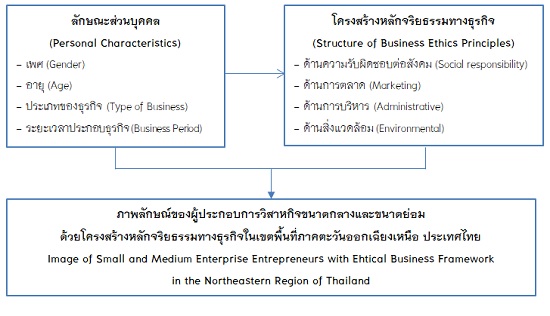ภาพลักษณ์ของผู้ประกอบการวิสาหกิจขนาดกลางและขนาดย่อม ตามโครงสร้างหลักจริยธรรมทางธุรกิจในเขตพื้นที่ภาคตะวันออกเฉียงเหนือ ประเทศไทย
DOI:
https://doi.org/10.14456/nrru-rdi.2024.4คำสำคัญ:
ภาพลักษณ์ผู้ประกอบการ, โครงสร้างหลักจริยธรรทางธุรกิจ, ผู้ประกอบการวิสาหกิจ, วิสาหกิจขนาดกลาง, วิสาหกิจขนาดย่อมบทคัดย่อ
วิธีดำเนินการของธุรกิจที่มีความถูกต้องทางทัศนศาสตร์ ความสุภาพ และเชื่อมั่น เป็นการปฏิบัติตามหลักและกฎเกณฑ์ที่ดีในสังคม นำมาสู่การวิจัยเชิงปริมาณที่มีวัตถุประสงค์เพื่อศึกษาลักษณะสวนบุคคล ที่มีผลตอภาพลักษณ์ตามโครงสร้างหลักจริยธรรมทางธุรกิจ และศึกษาอิทธิพลและความสัมพันธของโครงสร้างหลักจริยธรรมทางธุรกิจที่มีต่อภาพลักษณโดยรวมของผู้ประกอบการวิสาหกิจขนาดกลางและขนาดย่อมในเขตพื้นที่ภาคตะวันออกเฉียงเหนือ ประเทศไทย กำหนดขนาดกลุ่มตัวอย่าง 400 ราย และใช้วิธีการสุ่มตัวอย่างหลายขั้นตอน ทำการเก็บรวบรวมข้อมูลด้วยแบบสอบถามที่มีค่าความเชื่อมั่นเท่ากับ 0.963 ผ่านช่องทางออนไลน์ ได้รับการตอบกลับคืน 150 ราย คิดเป็นร้อยละ 37.50 นำข้อมูลที่ได้ มาวิเคราะห์ทางสถิติเพื่อหาค่าร้อยละ ค่าเฉลี่ย ค่าส่วนเบี่ยงเบนมาตรฐาน สถิติการทดสอบที (t-test) ด้วยการวิเคราะห์ความแปรปรวนแบบทางเดียว (One-Way Analysis of Variance) สถิติวิเคราะห์สัมประสิทธิ์การถดถอยพหุคูณ (Multiple linear Regression) และสถิติสหสัมพันธ์ (Correlation) ผลการวิจัยพบว่า ลักษณะส่วนบุคคล ประกอบด้วย เพศ ระดับอายุ ประเภทวิสาหกิจขนาดกลางและขนาดย่อม และระยะเวลาการประกอบการ ส่งผลต่อภาพลักษณ์โดยรวม ไม่แตกต่างกัน และโครงสร้างหลักจริยธรรมทางธุรกิจ ประกอบด้วย ด้านความรับผิดชอบต่อสังคม ด้านการตลาด ด้านการบริหาร และด้านสิ่งแวดล้อม มีความสัมพันธ์ในทางบวกกับภาพลักษณ์โดยรวมในระดับปานกลางถึงมากที่สุด (r=0.577-0.861) อย่างมีนัยสำคัญทางสถิติที่ระดับ 0.01 โดยโครงสร้างหลักจริยธรรมทางธุรกิจที่มีอิทธิพลต่อภาพลักษณ์โดยรวมและสามารถพยากรณ์ได้ 2 ด้าน คือ ด้านความรับผิดชอบต่อสังคมเพิ่มขึ้น 1 หน่วย จะส่งผลให้ภาพลักษณ์โดยรวมเพิ่มขึ้น 0.295 หน่วย และด้านการตลาดเพิ่มขึ้น 1 หน่วย จะส่งผลให้ภาพลักษณ์โดยรวมเพิ่มขึ้น 0.266 หน่วย ดังนั้น เจ้าของธุรกิจจำเป็นต้องให้ความตระหนักในการนำหลักจริยธรรมทางธุรกิจไปใช้ในการดำเนินกิจการเพื่อสร้างความน่าเชื่อถือ สร้างความไว้วางใจ เป็นพันธมิตรที่ดีต่อธุรกิจ ลูกค้า และชุมชน
References
Aaker, D. A., Kumar, V., & Day, G. S. (2001). Marketing Research (7th ed.). John Wiley & Sons.
Abbas, J., Mahmood, S., Ali, H., Ali Raza, M., Ali, G., Aman, J., ..., & Nurunnabi, M. (2019). The effects of corporate social responsibility practices and environmental factors through a moderating role of social media marketing on sustainable performance of business firms. Sustainability, 11(12), 3434. https://doi.org/10.3390/su11123434
Betakova, J., Pietrzak, M. B., & Iglinski, B. (2023). Effect of demographic characteristics of enterprises on the implementation of corporate social responsibility in SMEs context. Journal of Business Sectors, 1(1), 53-62. http://repozytorium.umk.pl/handle/item/6945
Boulding, K. E. (1975). The Image : Knowledge in life and Society. The University of Machigan.
Buchholtz, A. K. (2012). Business society: ethics stakeholder management (8th ed.). South Westrn/Cengage Learning.
Ferrell, O. C., Fraedrich, J., & Ferrell, L. (2000). Business Ethic: Decision Making and Case (4th ed.). Mifflin Company.
Frederick, W. C., Post, J. E., & Davis, K. (1992). Business and Society: Cooperate Strategy Public Police Ethic (7th ed.). McGraw-Hill.
Global Humanitarian Overview (GHO). (2023, January 6). Global Humanitarian Overview 2023. Humanitarian Action. https://humanitarianaction.info/gho2023
Hafner, A. W. (1998). Descriptive Statistical Techniques of Librarians (2nd ed.). American library Association.
Huang, X., Chau, K. Y., Tang, Y. M., & Iqbal, W. (2022). Business ethics and irrationality in SME during COVID-19: does it impact on sustainable business resilience?. Frontiers in Environmental Science, 10. https://doi.org/10.3389/fenvs.2022.870476
Jefkins, F. (1982). Public Relation Made Simple. Heinemann.
Kaewjamnong, A. (2013). Business Ethics (2nd ed.). Namsin Advertising.
Kunene, S., & Chummun, B. Z. (2023, December). The effects of a growth mindset in South African Small Businesses. In Conference proceedings Global Trends in Management, It and Governance in An e-World (e-MIG 2023), 26-27 October 2023 (pp. 193-205). South Africa : University of KwaZulu-Natal. https://www.researchgate.net/profile/Upasana-Singh/publication/376586020_eMIG_2023_Conference_proceedings/links/657e8131aff8b16813ad9e32/eMIG-2023-Conference-proceedings.pdf#page=199
Likert, R. (1967). The Method of Constructing and Attitude Scale. In Reading in Fishbeic, M (Ed.), Attitude Theory and Measurement (pp. 90-95). Wiley & Son.
Metzkera, Z., Ondrejkac, R., & Dvorskyd, J. (2023). The level of business ethics of small and medium-sized enterprises in the Visegrad Group. Serbian Journal of Management, 18(2), 285-294. DOI: 10.5937/sjm18-44958
Ministerial Regulations specifying the characteristics of small and medium sized enterprises, B.E. 2019. (2020, January 7). Royal Gazette. Volume 137, Part 1, Page 1.
Nash, L. (1990). Good Intentions Aside, A manager’s Guide to Resolving Ethical Problem. Harvard Business School Press.
Office of Small and Medium Enterprises Promotion. (2022). Situation Report MSME 2022. (n.p.).
Phisanbut, S. (2006). Business ethics (11th ed.). Faculty of Management Science, Suan Dusit Rajabhat Institute.
Piros, S., & Chaiyesh, T. (2022). Business Ethics Affect toPerformance of Small and Medium Generation X and Generation Y Entrepreneurs in Phitsanulok Province. Journal of Management Science Pibulsongkram Rajabhat University, 4(1), 1-17.
Post, J. E., Anne, T. L., & Weber, J. (2002). Business and Society. Mcgraw-Hill.
Rikharom, R. (2021). Ethics are Essential for Human Resources in an Organization. Journal of Local Management and Development, Pibulsongkram Rajabhat University, 1(1), 42-54.
Santos, Boaventura de Soursa. (1999). Toward a Multicultural Conception of Human Right. In Milk Featherstone and Scott Lash (eds.). SAGE Publications.
Serirat, S., Hiranyakitti, S., & Tangsinsiri, T. (2007). Management and organizational behavior. Teera Film and Sitex.
Srisa-Ard, B. (2017). Basic research (10th ed.). Suweeriyasan.
Tangkrajang, A., Phangniran, B., & Sokaew, T. (2003). Business ethics. Thammasan.
Tiep, L. T., Ngo, H. Q., & Aureliano-Silva, L. (2023). Contribution of corporate social responsibility on SMEs' performance in an emerging market–the mediating roles of brand trust and brand loyalty. International Journal of Emerging Markets, 18(8), 1868-1891. https://doi.org/10.1108/IJOEM-12-2020-1516
Tirakanan, S. (2006). The use of statistics in social science research: guidelines for practice (2nd ed., Reviesed). Chulalongkorn University Press.
United Nations. (n.d.). 60 ways the United Nations makes a difference. Office of United Nations Thailand (Translation). https://unic.un.org/aroundworld/unics/common/documents/publications /60ways/bangkok_60ways_thai.pdf
Velasquez, M. G. (2002). Business Ethics: Concept and Case (5th ed.). Prentice Hall.
Wanichbancha, K. (2009). Multivariate data analysis (4th ed.). Thammasan.
Wanichbancha, K., & Wanichbancha, T. (2015). Using SPSS for windows to analyze data (15th ed.). Department of Statistics, Faculty of Commerce and Accountancy, Chulalongkorn University.
Watchangngen, P. (2003). Business ethics. Amornphim.
Yaviraj, N. (2008). Business Ethics (2nd ed., Revised). Triple Group.

Downloads
เผยแพร่แล้ว
How to Cite
ฉบับ
บท
License
Copyright (c) 2024 สถาบันวิจัยและพัฒนา มหาวิทยาลัยราชภัฏนครราชสีมา

This work is licensed under a Creative Commons Attribution-NonCommercial-NoDerivatives 4.0 International License.



